




Your support is critical to our success.

Origin and Habitat: Encephalartos whitelockii is endemic to a single location, where it forms one of the largest and most impressive cycad populations in Africa in the Kabarole district of the southwestern part of Uganda (possibly the largest single cycads colony in Africa). Populations occur along the Mpanga river, above and below the Mpanga River Falls, just before it runs into Lake George. The population size of E. whitelockii is estimated to be 8,000 mature individuals. This species has a small extent of occurrence and area of occupancy.
Altitude range: This species is recorded from an altitude of 1,000 to 1,300 meres above sea level.
Habitat and ecology: This species grows on almost sheer granite faces and on rocky slopes, amongst tall grass in savanna. Also occurs in dense evergreen montane forests. Seedlings and small plants are absent from open habitats which may be as a result of too frequent fires, but under forest canopy, prolific regeneration occurs. The seeds are large and have a fleshy outer coat and are desirable to a range of animals. However the unpalatable seed is discarded some distance away from the parent plant in a hospitable environment in which to germinate. The seeds of E. whitelockii are an important food source for baboons. This species is not only pollinated by wind but also by insects or more specifically weevils. To attract pollinators, male and female cones produce powerful odours, usually in the early morning or evening. Travelling between the sexes, the weevils pollinate the plants by inadvertently transferring pollen from the male cones to the receptive ovules of the female cones. Threats to the species includes the construction of a small hydro electric power plant on the Mpanga River Falls, the construction of roads and camps in the cycad belt, causing soil erosion and deep gulleys, reducing habitat quality, the reduction in population of mature and young individuals as they are knocked down by heavy machinery and reduction in area of occupancy owing to parts being occupied by weir (reservoir), water canal, and power house. Moreover it is reported that the collection of seed and seedlings for commercial trade may impair the regeneration capacity of the cycad and thus lead to further reduction of its population. Other threads are the cultivation on the slopes of the gorge and clearing of the cycads, harvesting of the cycad leaves for building materials, burning of some areas occupied by the cycad for stimulation of grazing pasture. Geographically E. whitelockii occurs closest to Encephalartos ituriensis, but these species are separated by the Rift Valley, which probably represents a strong isolating factor
Synonyms:
- Encephalartos whitelockii P.J.H.Hurter
Encephalartos whitelockii P.J.H.Hurter
Phytologia 78: 410 (1995)
Synonymy: 2
- Encephalartos whitelockii P.J.H.Hurter
- Encephalartos successibus Vorster
Description: Encephalartos whitelockiiSN|31780]]SN|31780]] is a large, spectacular, evergreen, arborescent cycad up to 4 metre tall. Each stem is topped with a crown of long, stiff, dark green, glossy fronds which curve gently backwards. The fronds are composed by falcate, well-spaced, dentate leaflets that curve towards the frond apex and carry more than 3 teeth on each margin. The teeth on the lower margin are also well-spaced rather than crowded to the base. The bluish-green cones with smooth scale apices, the sessile seed cones and the long-stalked, often pendulous pollen cones are also distinctive. The reproductive organs take the form of cones, similar in appearance to those of a conifer, with the male and female cones being borne on separate plants. Male plants of E. whitelockii produce up to five, pendulous, bluish-green cones per stem, while female plants produce up to three, bluish-green egg-shaped cones. E. whitelockii is a long-lived, slow growing plant that always occur as individual male or female plants. There is no way of determining the sex of a cycad until it begins to produce its first cone.
Derivation of specific name: E. whitelockii are named in recognition of Loran Whitelock of Los Angeles, California, well-known contemporary student and collector of cycads for its extensive research on cycad flora.
Stem: Erect up to 4 m tall, 35-40 cm in diameter typically growing in large clumps. The stems although woody in appearance, are mostly comprised of soft, pithy storage tissue protected by a solid layer of old leaf bases.
Leaves: 310-410 cm long, dark green, highly glossy, slightly keeled (opposing leaflets inserted at 160° on rachis). Rachis green, gently curved, somewhat lax or straight with last third sharply recurved, not spirally twisted. Petiole straight, with 6-12 prickles, spine-free for 13 cm; leaf-base collar not present; basal leaflets reducing to spines. Leaflets lanceolate, strongly discolorous, not overlapping, not lobed, insertion angle horizontal; margins flat; upper margin heavily toothed (more than 3 teeth); lower margin heavily toothed (more than 3 teeth); median leaflets 23-30 cm long, 20-28 mm wide.
Male cones: 1-5, narrowly ovoid, green or yellow, 50 cm long, 9 cm in diameter.
Female cones: 1-3, ovoid, green or yellow, 45 cm long, 35 cm in diameter.
Seeds: Ovoid, 30-35 mm long, 25-30 mm wide, sarcotesta red.
Notes: The cycads are relicts of an ancient order of coniferous plants that flourished some 300 to 200 million years ago, with the aptly prehistoric appearance of an overgrown tree fern perched on top of a palm stem.
Bibliography: Major references and further lectures
1) Kalema, J. 2010. Encephalartos whitelockii. The IUCN Red List of Threatened Species. Version 2015.2. <www.iucnredlist.org>. Downloaded on 23 August 2015.
2) Terrence Walters, Roy Osborne “Cycad Classification: Concepts and Recommendations” CABI, 12 January 2004
3) Philip Briggs, Andrew Roberts “Uganda” Bradt Travel Guides, 2010
4) Adansonia, Volume 8; Volume 20 page 225, Editions scientifiques du Muséum, 1998
5) Whitelock, Loran M., “The Cycads”, Timber press, 2002
6) Haynes J.L, “World List of Cycads: A Historical Review”, IUCN/SSC Cycad Specialist Group, 2011
7) Ken Hill: “Encephalartos whitelockii – In The Cycad Pages.” <http://plantnet.rbgsyd.nsw.gov.au/PlantNet/cycad/> Downloaded on 23 August 2015
8) Jolivet, P. “Cycads and beetles: recent views on pollination.” The Cycad Newsletter, 28: 3-7. 2005
9) Palm and Cycad Societies of Australia (PACSOA) (February, 2010) http://www.pacsoa.org.au/cycads/Encephalartos/whitelockii.html web 23 August 2015
10) Roberts, A. “New threat to Uganda’s cycads.” Oryx, 42: 325. 2008
11) Donaldson, J.S. “Is there a floral parasite mutualism in cycad pollination? The pollination biology of Encephalartos villosus (Zamiaceae).” American Journal of Botany, 84: 1398 – 1406. 1997
12) Dennis Kamoga “ommunity Based Conservation of Endemic-Ugandan Cycad, Encephalartos whitelockii PHJ Hurter in the Mpanga Gorge Areas” The Rufford Small Grants for Nature Conservation (Project Update: August 2010 )
http://www.ruffordsmallgrants.org/rsg/projects/dennis_kamoga web 22 Aug. 2015.
13) "Cycad (Encephalartos whitelockii") in ARKive, Images of Life on Earth. <http://www.arkive.org/cycad/encephalartos-whitelockii/>
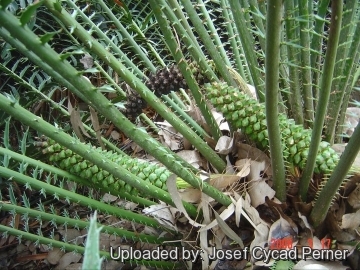
Encephalartos whitelockii Photo by: Josef Cycad Perner
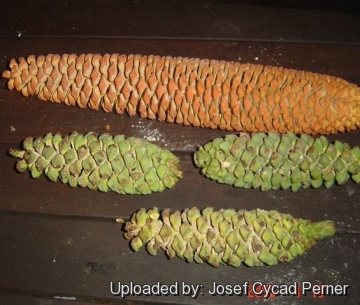
Encephalartos whitelockii green male cone, and larger Encephalartos gratus male cones. Photo by: Josef Cycad Perner
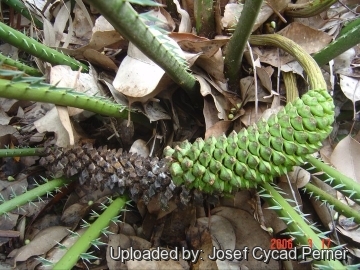
Male cones in Joe's Cycad Gardens. Photo by: Josef Cycad Perner

Male cones in Joe's Cycad Gardens. Photo by: Josef Cycad Perner
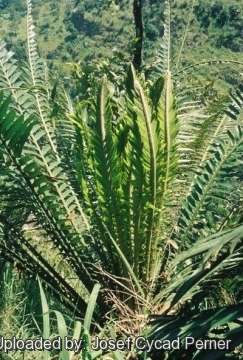
New emerging fronds in habitat. Photo by: Josef Cycad Perner
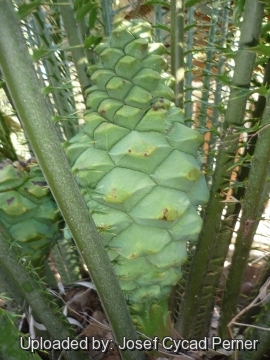
Female cones in Joe's Cycad Gardens. Photo by: Josef Cycad Perner
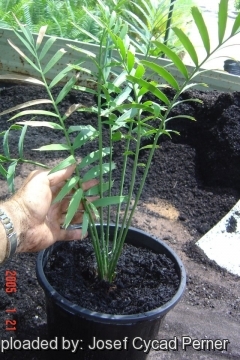
Encephalartos whitelockii Photo by: Josef Cycad Perner
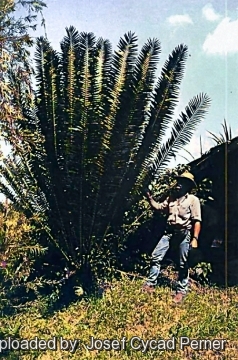
Encephalartos whitelockii and Joe in Fort Portal, Western Uganda. Photo by: Josef Cycad Perner
Cultivation and Propagation: As a garden subject, Encephalartos whitelockiiSN|31780]]SN|31780]] is one of the most spectacular of all cycad species. The seedlings grow rapidly, developing into an attractive garden plant with 1 m long leaves in four to five years. This is one of the fastest growing cycads and responds well to cultivation provided it has a well-drained soil, frost-free conditions and regular watering during the dry months. It is an adaptable plant well suited to subtropical climates. It can be grown in full sun without its leaves burning. When young they can be grown as a container plant and eventually transplanted into the garden. As a garden plant, this cycad will usually hold two or three crowns of leaves, all in good condition.
Growing rate: It is a very vigorous grower. Needs a large garden due to its size.
Soils: It prefer well drained, gritty soil with plenty of water, especially in dry weather.
Transplanting: This species transplants easily as a mature plant, although it is recommended to remove all of the leaves before doing so. This makes for easier handling and the plant will recover sooner due to less moisture loss.
Waterings: In cultivation prefers moist soil with good drainage for optimal growth. But it is eventually drought resistant. Irrigation systems can be detrimental to cycads, damaging the leaves and stems from the pressure of the water as well as over-watering.
Fertilization: Naturally undemanding for nutrients, it responds very well to regular applications of fertilizer. Growth can be greatly improved through the application of fertilizers. Most growers find that a fertilizer having an even NPK (Nitrogen, Phosphorus, Potassium) balance, and supplemental trace elements, provides a good start for cycads.
Exposure: It thrives and grows best in full sun or partial shade.
Wind tolerance: It prefers a sheltered position providing protection from the prevailing winds.
Hardiness: Frost sensitive (USDA zones 10-12) .
Propagation: It may be propagated by seeds. They are among the easiest plants to germinate.
| Your Actions | |
|---|---|
| Back to Encephalartos index | |
| Back to Zamiaceae index | |
 |
Back to Palms And Cycads Encyclopedia index |
Privacy stantement - Terms and conditions - How to cite - About us - Feedback - Donate




